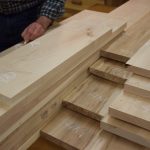We may receive a commission when you use our affiliate links. However, this does not impact our recommendations.
‘ Teak oil’ is whatever a manufacturer chooses to put in the container.
Teak oil’ is whatever a manufacturer chooses to put in the container.
by Bob Flexner
page 38
No wood finish illustrates better than “teak oil” why finishing is so confusing. Brands vary from mineral oil, to linseed oil, to tung oil, to oil/varnish blend, to wiping varnish, to simply wax and turpentine.
Many brands claim or imply ultraviolet resistance. But my tests, and the experiences of many in the wooden-boat community, contradict this. From a technical standpoint, these finishes are applied too thin to be effective, even if manufacturers have actually added UV absorbers.
Some brands claim to be formulated specifically for teak and other oily woods, but they don’t dry better, which is what you would want for an oily wood that retards the drying of oils and varnishes. Others claim to “feed” the wood or replace natural oils, which is silly. No wood needs feeding, and teak’s natural oily resin can’t be replaced.
Commercially available teak oils are all over the map with their claims. One truth that can be said about them all is that none has anything to do with teak wood or teak trees. Teak trees aren’t drained of their oily resin to make teak oil.
Here’s some background about “oil” finishes. Twenty-five years ago, I wrote an article in Woodwork Magazine attempting to make sense of the many wipe-on finishes sold as oil. These included raw and boiled linseed oil, tung oil, oil/varnish blend and thinned varnish (not oil at all) that I called “wiping varnish.”
Due primarily to manufacturer mislabeling, there was tremendous confusion in woodworking circles. I spent most days for three months testing products and even had some examined by a chemist trying to figure out what they were. It turned out to be pretty simple, of course, and you probably have a good understanding now because, even though few manufacturers have mended their mislabeling ways, most writers and teachers have adopted the vocabulary and definitions I suggested.
Articles: You’ll find many free finishing articles on our web site.
In Our Store: “Flexner on Finishing” – 12 years of columns illustrated with beautiful full-color images and updated, and “Wood Finishing 101.”
From the February 2015 issue, #216
Here are some supplies and tools we find essential in our everyday work around the shop. We may receive a commission from sales referred by our links; however, we have carefully selected these products for their usefulness and quality.











